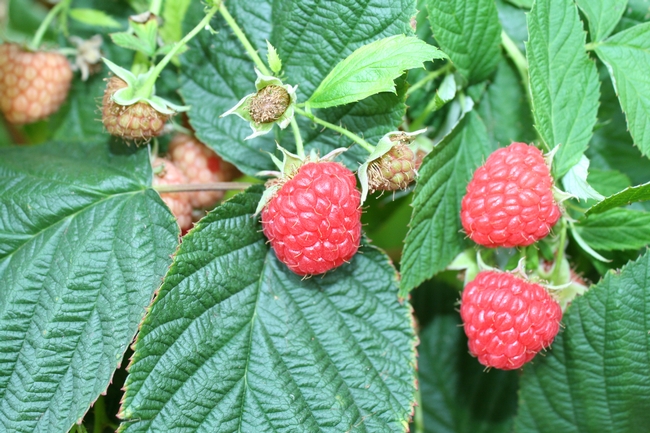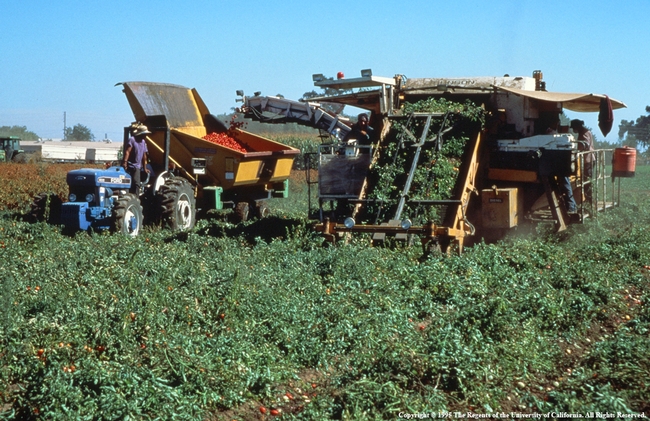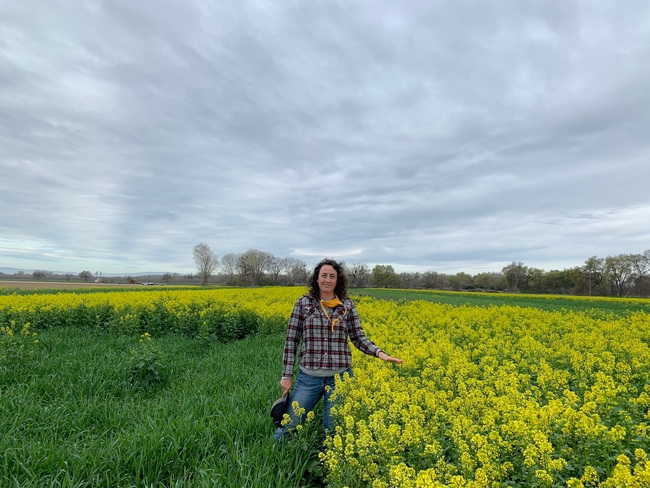Posts Tagged: study
New UC study estimates raspberry production costs on Central Coast
A new study that estimates costs and potential returns for growing raspberries on the Central Coast is available for free from UC Agriculture and Natural Resources, UC Cooperative Extension and the UC Davis Department of Agricultural and Resource Economics.
“These studies provide growers with a baseline to estimate their own costs, which can help when applying for production loans, projecting labor costs, securing market arrangements, or understanding costs associated with water and nutrient management and regulatory programs,” said Brittney Goodrich, UC Cooperative Extension specialist and study co-author.
The UC Cooperative Extension study focuses on raspberries grown in Santa Cruz, Monterey and San Benito counties for the fresh market.
The cost study models a management scenario for a 45-acre farm, 42 acres of which are planted to raspberries. The remaining acres are for the irrigation system, roads and buildings. Each study describes the cultural practices used for establishing, producing and harvesting raspberries, including land preparation, soil fertility and pest management, irrigation and labor needs.
The 36-page study shows costs for each operation, material inputs and costs, and cash and non-cash overhead costs in a variety of formats for three production years. A ranging analysis for each production year is also included and shows potential profits or losses over a range of prices and yields. The authors also note California's 2023 minimum wage and overtime rules.
The new study, “2023 Sample Costs to Produce and Harvest Raspberries,” can be downloaded from the UC Davis Department of Agricultural and Resource Economics website at https://coststudies.ucdavis.edu.
For a detailed explanation of the assumptions and calculations used to estimate the costs and potential returns for each crop, readers can refer to the narrative portion of the study.
For more information, contact Mark Bolda, University of California Cooperative Extension farm advisor, at mpbolda@ucanr.edu, Laura Tourte, emeritus UC Cooperative Extension farm advisor, at ljtourte@ucanr.edu, or Jeremy Murdock in the Department of Agricultural and Resource Economics at jmmurdock@ucdavis.edu.
Sample cost of production studies for many other commodities grown in California are also available for free at https://coststudies.ucdavis.edu.
New cost study for processing tomatoes released by UC
A study on the costs and returns for growing processing tomatoes has been updated by the University of California, Davis Department of Agricultural and Resource Economics and UC Cooperative Extension.
The newly released analysis is based upon a hypothetical well-managed farming operation using sub-surface drip irrigation and farming practices common in the Sacramento Valley and northern Delta. The costs, materials and practices shown in this study will not apply to all farms.
The cost study is authored by Brenna Aegerter, UCCE farm advisor for San Joaquin County; Patricia Lazicki, UCCE farm advisor for Yolo, Solano and Sacramento counties; Donald Stewart, staff research associate in the UC Davis Department of Agricultural & Resource Economics; Gene Miyao, emeritus UCCE farm advisor; and Brittney Goodrich, UC Davis assistant professor of Cooperative Extension.
The analysis is based on a hypothetical farm with 3,500 non-contiguous acres, which are leased. Tomatoes are grown on 1,000 acres. All 1,000 acres of processing tomatoes are irrigated with sub-surface drip. The remaining 2,500 acres are planted to other rotational crops including alfalfa hay, field corn, safflower, sunflower, vine seed and wheat. The yield of 46 tons per acre is used to reflect the region's typical yields.
UC Cooperative Extension farm advisors and other agricultural associates provided input and reviews. The authors describe the assumptions used to identify current costs for the processing tomato crop, material inputs, cash overhead, and non-cash overhead. Ranging analysis tables show net profits over a range of prices and yields. Other tables show the monthly cash costs, the costs and returns per acre, hourly equipment costs, and equipment, investment and business overhead costs.
The new study, “Sample Costs to Produce Processing Tomatoes in the Sacramento Valley and Northern Delta - 2023,” and sample cost of production studies for many other commodities can be downloaded for free from the UC Davis Department of Agricultural and Resource Economics website at http://coststudies.ucdavis.edu.
For additional information or an explanation of the calculations used in the studies, contact Goodrich at bkgoodrich@ucdavis.edu, Aegerter at bjaegerter@ucanr.edu, or Lazicki at palazicki@ucanr.edu.
New UC study helps growers estimate cover crop costs and potential benefits
Cover crops offer many potential benefits – including improving soil health – but not knowing the costs can be a barrier for growers who want to try this practice. To help growers calculate costs per acre, a new study on the costs and potential benefits of adding a winter cover crop in an annual rotation has been released by UC Agriculture and Natural Resources, UC Cooperative Extension and the UC Davis Department of Agricultural and Resource Economics.
Led by UC Cooperative Extension farm advisors Sarah Light and Margaret Lloyd, the cost study is modeled for a vegetable-field crop rotation planted on 60-inch beds in the lower Sacramento Valley of California. Depending on the operation, this rotation may include processing tomatoes, corn, sunflower, cotton, sorghum and dry beans, as well as other summer annual crops.
“This cost study can be used by growers who want to begin cover cropping to determine the potential costs per acre associated with this soil-health practice,” said Light, a study co-author and UC Cooperative Extension agronomy advisor for Sutter, Yuba and Colusa counties.
“Based on interviews with growers who currently cover crop on their farms, this cost study models a management scenario that is common for the Sacramento Valley. In addition, growers who want to use cover crops can gain insight as to what standard field management practices will be from planting to termination.”
At the hypothetical farm, the cover crop is seeded into dry soil using a grain drill, then dependent on rainfall for germination and growth.
“Given the frequency of drier winters, we included the cost to irrigate one out of three years,” said Lloyd.
A mix of 30% bell bean, 30% field pea, 20% vetch and 20% oats is sown in the fall. Depending on winter rainfall, soil moisture and the following cash crop, the cover crop is terminated in mid to late spring. The cover crop is flail mowed and disced to incorporate the residue into the soil.
The study includes detailed information on the potential benefits and the drawbacks of cover cropping.
Another consideration for growers is that multiple programs such as CDFA's Healthy Soils Program, various USDA-funded programs (EQUIP, the Climate-Smart Commodities, etc.), and Seeds for Bees by Project Apis m. offer financial incentives for growers to implement conservation practices, such as cover crops.
“This study can provide growers with a baseline to estimate their own costs of using winter cover crops as a practice. This can be useful to calculate more precise estimates when applying for some of these programs and/or weigh the costs per acre with expected benefits in terms of soil health, crop insurance premium discounts or other benefits provided by the cover crops,” said Brittney Goodrich, UC Cooperative Extension agricultural and resource economics specialist and study co-author.
“Last year, the USDA's Pandemic Cover Crop Program gave up to a $5/acre discount on crop insurance premiums for growers who planted a cover crop, and there is potential this will get extended going forward,” Goodrich said.
A list of links to resources that focus specifically on cover crops is included in the study. Five tables show the individual costs of each cultural operation from ground preparation through planting and residue incorporation.
The new study, “2022 - Estimated Costs and Potential Benefits for a Winter Cover Crop in an Annual Crop Rotation - Lower Sacramento Valley,” can be downloaded from the UC Davis Department of Agricultural and Resource Economics website at coststudies.ucdavis.edu. Sample cost of production studies for many other commodities are also available on the website.
This cost and returns study is funded by the UC Davis Department of Agricultural and Resource Economics.
For an explanation of calculations used in the study, refer to the section titled “Assumptions.” For more information, contact Don Stewart in the Department of Agricultural and Resource Economics at destewart@ucdavis.edu, Light at selight@ucanr.edu, or Lloyd at mglloyd@ucanr.edu.
Study: Government shutdown stressed food assistance program participants
A U.S. federal government shutdown can represent a minor inconvenience, a delay in paychecks, or – for people living in some of the most difficult circumstances – an extended period of hunger and anxiety.
A study published recently in the journal Nutrients provides a unique glimpse into the shutdown experiences of participants in CalFresh – California's name for the federally funded Supplemental Nutrition Assistance Program (formerly known as food stamps). Currently, about 42 million people participate in SNAP across the U.S.
In focus groups conducted in 2019 with 26 low-income CalFresh participants from four diverse California counties, participants shared how the 2018-19 federal government shutdown affected their SNAP benefits, their perception of the program and their faith in government.
One of the immediate effects of the 2018-19 shutdown was that February CalFresh benefits were distributed in January. And while that meant program participants saw extra benefits that month, they then had to wait 40 to 44 days until the March issuance – much longer than the usual 28 to 31 day cycle.
“What we saw with this study is that this extended lag in benefit receipt from January to March was devastating,” said Wendi Gosliner, senior researcher and policy advisor at the Nutrition Policy Institute of UC Agriculture and Natural Resources, and an author of the study funded by UC ANR.
She recalled one participant who, despite having a gastrointestinal issue that requires a special diet, had to eat canned food from the food bank that made her sick – rather than go hungry while waiting for her March benefits. Others described cascading financial challenges after using rent money for food in February, or going into debt to pay for food and getting behind on other expenses.
The study also chronicles the experiences of a woman who was anguished to hear the suffering of her daughter, also a CalFresh participant: “She called me several times crying, ‘Ma, I don't – we don't have enough food. What am I going to do…? You know, I can't afford to this and this and this.' And I can't help her.”
For individuals grappling with food insecurity, the stress of feeding their families was compounded by the uncertainties of the government shutdown. And while many participants exercised their agency and resourcefulness in coping with the situation, they also felt a degree of powerlessness amid the “confusion and craziness,” as one person put it.
“No one knew how long that shutdown was going to last; no one knew if the March benefits were going to be paid,” Gosliner said. “And as we learned, there were all kinds of stories circulating out there about what was going on with the uncertainty – a lot of people didn't have the information about what was actually happening.”
Some participants, seeing the “double benefit” in January 2019, thought that it was the last-ever distribution and that SNAP was ending. Others described being unable to get in touch with the CalFresh agency to get their questions answered about the benefits. Most participants had not heard about the disrupted benefit schedule before receiving the benefits. As a result, many people in the focus groups shared that their overall faith in government had been shaken.
Improving customer service, boosting benefit levels and adjusting eligibility and benefit formulas to reflect high cost-of-living and expenses related to working were three recommendations that came from the focus group participants.
A fourth recommendation tackles the shutdown issue head-on: Don't let it happen again.
“Congress should do absolutely everything in their power to be sure that the program operates on the usual time schedule – even if the government is shut down,” Gosliner said.
In the context of the global pandemic, when financial and social inequities and physical and mental health disparities have been laid bare, ensuring access to healthful food is even more important. And with studies showing that hospitalizations increase with longer lags between SNAP distributions, Gosliner said the “absolute last thing” the overburdened health system needs is more people in emergency departments seeking acute care.
“It's the worst time to be having people who need money to feed their families face additional insecurity,” she said. “It's critically important that Congress acts to be sure that there is not any disruption in benefits.”
The authors of the study, “Participants' Experiences of the 2018–2019 Government Shutdown and Subsequent Supplemental Nutrition Assistance Program (SNAP) Benefit Disruption Can Inform Future Policy,” are Wendi Gosliner, Wei-Ting Chen, Cathryn Johnson, Elsa Michelle Esparza, Natalie Price, Ken Hecht and Lorrene Ritchie.
The study can be found online at https://www.ncbi.nlm.nih.gov/pmc/articles/PMC7353319.





